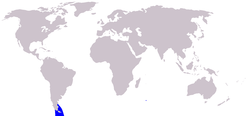Commerson's Dolphin
|
|
| Commerson's Dolphin Conservation status: Unknown | ||||||||||||||||||
|---|---|---|---|---|---|---|---|---|---|---|---|---|---|---|---|---|---|---|
| Scientific classification | ||||||||||||||||||
| ||||||||||||||||||
| Binomial name | ||||||||||||||||||
| Cephalorhynchus commersonii Lacépède, 1804 | ||||||||||||||||||
 Commerson's Dolphin range |
Commerson's Dolphin (Cephalorhynchus commersonii) is one of four dolphins in the Cephalorhynchus genus. The species has also the common names Skunk Dolphin and Piebald Dolphin. The dolphin is found in two geographical distinct areas - around the southern tip of South America around Tierra del Fuego and the Falkland Islands and near the Kerguelen Islands in the southern part of the Indian Ocean.
| Contents |
Physical description
Commerson's Dolphin has a very distinctive patterning. It has a black head, dorsal fin and fluke and white throat and body. The demarcation between the two colours is very clear-cut. In shape and size - the creature is stocky and grows to around 150cm - resembles that of that a porpoise but its conspicious behaviour (see behaviour below) is typical of a dolphin. The dorsal fin has a long, straight leading edge leading to a curved tip. The trailing is typically concave but not falcate. The fluke has a notch in the middle. The dolphin has no beak.
Females reach breeding age at six to nine years. Males reach sexual maturation at about the same age. Mating occurs in the spring and summer and calving occurs after a gestation period of 11 months. The oldest known Commerson's Dolphin died at age 18.
Population and distribution
The species is distributed in two locations. The larger population is found inshore in various inlets in Argentina, in the Strait of Magellan and near the Falkland Islands. The second population is resident close to the Kerguelen Islands, 8000km to the east of their nearest special cousins. They prefer shallow waters. Global populations are unknown, but the species is accepted to be locally common. A survey in 1984 estimated there to be 3400 individuals in the Strait of Magellan.
Behaviour
Commerson's Dolphin is very active. It is often seen swimming rapidly on the surface and leaping from it. It also spins and twists as it swims and may surf on breaking waves when very close to the shore. It will bow-ride and swim behind fast-moving boats.
The dolphin feeds on a mix of coastal and pelagic fish and squid. Those in the South American sub-population supplement their diet with crustaceans.
Conservation
The IUCN lists Commerson's Dolphin as data deficient in its Red List of Threatened Species. The proximity of the dolphin to the shore makes accidental killing in gillnets a common occurrence. The dolphin was killed for use as crab bait by some Argentianian and Chilean fishermen in the 1970s and 80s. This practice has now tailed off.
References
- National Audubon Society: Guide to Marine Mammals of the World ISBN 0375411410
- Encyclopedia of Marine Mammals ISBN 0125513402de:Commerson-Delfin
